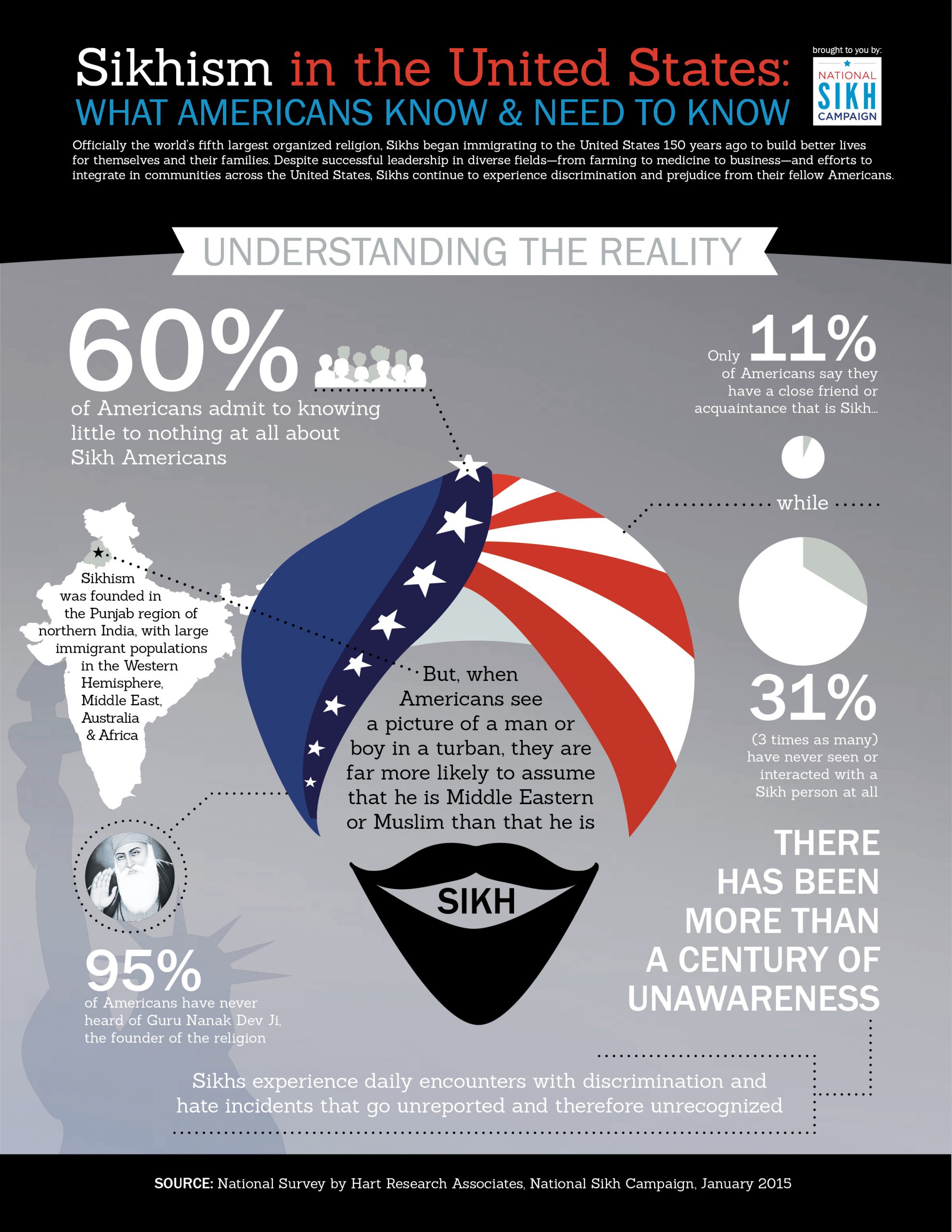About Sikhi
Sikhs in the USA

Sikhism, officially recognized as the world’s fifth-largest organized religion, holds a unique and significant place in the cultural mosaic of the United States. Sikh immigrants began arriving in the United States 150 years ago, driven by dreams of prosperity for themselves and their families. Over time, Sikhs have not only succeeded but excelled in a wide array of fields, from farming and medicine to entrepreneurship and technology, making vital contributions to the nation’s progress. Despite these achievements and their efforts to seamlessly integrate into American society, Sikh Americans continue to face instances of discrimination and prejudice, often rooted in misunderstandings about their faith and traditions.
Sikhism, founded in the Punjab region of northern India by Guru Nanak Dev Ji in the 15th century, is a faith centered on principles of equality, justice, and devotion. In recent decades, Sikhism has transcended its Indian origins to become a global religion, with substantial immigrant populations in the Western Hemisphere, Middle East, Australia, and Africa.
The visual identity of Sikh men, characterized by their turbans (dastaars) and beards, serves as a symbol of their commitment to Sikhism’s core values. Unfortunately, these distinct features can sometimes lead to misperceptions and, in some cases, discrimination. Increasing awareness and understanding of Sikhism is vital to fostering a more inclusive and harmonious society. Sikh Americans have long championed education and outreach to bridge these gaps, striving to create a more informed and empathetic nation.
Before Visiting Gurdwara Sahib
The term ‘Gurdwara,’ pronounced as ‘Gur-Dwa-raa,’ translates to the ‘Guru’s Door’ or ‘path through the Guru.’ It signifies a sacred space where Sikhs gather to seek spiritual guidance, moral wisdom, and the blessings of their Guru. In the Western world, Gurdwaras are commonly known as Sikh Places of Worship. Before embarking on your visit to a Gurdwara, there are important preparations to observe. Dressing modestly is a fundamental requirement, including taking a shower and wearing appropriate attire that covers the body respectfully. It is strictly prohibited to bring alcohol, cigarettes, or drugs onto the premises or to be under their influence. Additionally, wearing hats or caps is considered inappropriate. Upon arrival, visitors are expected to cover their heads with provided scarves as a sign of respect. Removing shoes and socks before entering the Gurdwara is not only a gesture of cleanliness but also a mark of reverence to Guru Sahib Ji, the spiritual owner of the Gurdwara. It is advisable to wash and dry your feet before proceeding to the Darbar Hall. Good hand hygiene is essential, so washing your hands with soap is recommended, especially before and after eating and before engaging in prayer. A typical Gurdwara consists of two primary halls: the Darbar Hall, where congregational prayers take place, and the Langar Hall, where communal meals are served. Remember to turn off your phone upon entering the Darbar Hall to help maintain the peaceful and sacred atmosphere.

About Sikhi QnAs
What is Vand ke Chakna?
Vand ke Chakna (sharing with others) is an important principle in Sikhi. We should share what we have with others around us, especially the needy. Guru Sahib Ji tells us that hoarding materialistic possessions, being selfish and only looking out for our own needs is not the path of a Sikh.
Why Guru Gobind Singh Ji Kept a Baaj (Falcon/Hawk)?
A Baaj (falcon/hawk) represents the traits of the Khalsa. Below are the eight reasons for Guru Gobind Singh Ji keeping a Baaj:
- Cannot be enslaved
- Independent
- Flies very high but keeps vision low (Humility)
- Chakarvarti (Always moving and unattached)
- Never lazy
- Flies against the wind (Unique)
- Fearless
- Royalty (King of the sky)
What is the Greatness of Doing Ardaas and Matha Tek?
One must reap what they sow in this life based on Karma. Upon all of our foreheads, Vaheguru has placed the mark of our fate. When we do Ardaas to Guru Sahib, they bless us with what we ask for. The question now arises, how does Guru Sahib bless us with what we want if our destiny is already pre-written? Guru Gobind Singh Ji once explained this using the analogy of a stamp/seal. If one is to look at a stamp/seal before it is stamped, it will be backwards. Until the seal is stamped onto the paper, it cannot be read. This is the state of our bad actions, when a Sikh bows down and touches his/her forehead onto the feet of the True Guru with utmost faith, then those bad fortunes become obverse. Just like the stamp on the paper, our bad fortune become reversed and become good fortune. Guru Gobind Singh Ji teach us here that bowing down to your Guru with full faith is a great action. To learn more about this topic, read our article on the Greatness of Doing Ardaas and Matha Tek.
Why is it Important to Do Rehraas Sahib?
The time of Amrit Vela (Ambrosial hours before dawn) and the time of Rehraas Sahib (evening daily Sikh Prayer) are essential in a Sikh’s life. During these two periods our attendance is taken into account even in Sachkhand (the Realm of Truth). Those who did not do Rehraas Sahib whilst alive are removed from Vaheguru’s court for three hours every evening. One should take time out every evening to do Rehraas Sahib and listen to the Guru’s Hukam. To learn more about this topic, check out our article on Importance of Doing Rehraas Sahib.
Why Do Sikhs Wear Turbans?
A Dastar (turban) serves as a constant reminder that God is forever present. It is an insignia of Guru Ji’s teaching that a Sikh must hold a high level of moral responsibility. A Dastar also gives Sikhs their unique identity and it is a royal crown given to Sikhs by the Gurus. A Dastar symbolizes equality and does not discriminate against anyone.
Do the Different Colors and Styles Mean Anything?
Essentially, no. Some styles, such as the Dumalla (du=two, malla=materials) were more commonly worn by Sikh warriors. Other styles may be more predominant in certain Sikh communities, such as the triangle style for Sikhs from Kenya.
Do All Sikhs Wear a Dastar?
All Sikhs have been ordained to keep their hair; therefore, most practicing Sikhs will wear a Dastar. Sikhi has no age or gender barriers, so women and children can also wear a Dastar. Some women and younger Sikhs may also wear a variety of head coverings such as a Chunni, Rumaal or Patka.
It is very disrespectful to touch or ask a Sikh to remove their Dastar. A Sikh will only remove the Dastar in extreme circumstances or when showering/sleeping, while still keeping their head covered. It is not headwear but an article of faith. A Sikh will treat Dastar with great respect even when removing it.
What is the Greatness of Satsangat (Holy Congregation)?
Sometimes we wonder why it is so important to go into Satsangat (true/holy congregation)? What is the Greatness of Satsangat? A lot of the time when we read Gurbani our mind struggles to focus. Guru Sahib teaches us that at this time we should go into the Satsangat where our mind will settle. There are three main benefits of going into the Satsangat: when we go to the Sangat our challenges are solved, our sins are washed away, and our sleeping mind awakes to the truth of Vaheguru. Through the Satsangat our life can change.
To learn more about this topic, read our article on the Greatness of Satsangat – Advice by Guru Har Rai Ji.
What are the Ten Qualities of a Dharmik (Righteous) Person?
The ten qualities of a Dharmik Person are,
- Khima – Forgiving nature
- Ahinsa – Non-violence
- Daya – Compassionate nature
- Mridh – Speaking sweetly, polite nature
- Sat Bachan – Speaking the truth
- Tap – Meditation, penance, Seva (Selfless service)
- Daan – Giving nature
- Seel – Calm and patient nature
- Soch – Pure
- Trisna Bina – Without any desire
We should all attempt to bring these ten qualities into our lives. To learn more about these qualities and what the realm of Dharam (Dharam Khand) is, check out our article on the Ten Qualities of Dharmik Person.
Did Guru Nanak Dev Ji say to become a human first?
No. It’s not in Gurbani and nor is it in our history. People will sell you a version of Sikhi which is not Sikhi and you might end up buying it.
